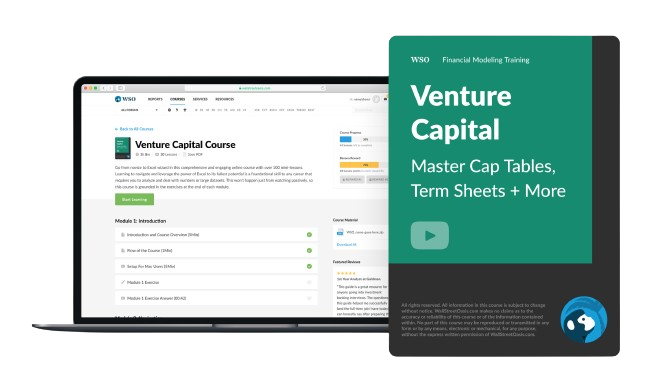Post-Money Valuation
Post-money valuation refers to the valuation of a company immediately after an investment or financing event, such as a round of venture capital investment
What is the Post-Money Valuation?
Post-money valuation is the estimated value of a company after it has received external funding, like investments from venture capitalists or angel investors. It tells you how much the company is worth after this financial boost.
Pre-money valuations are valuations that are computed before these funds are included. The sum of any additional equity received from outside investors is added to the pre-money valuation to determine the post-money valuation.
Pre-money valuations are used by investors like venture capitalists and angel investors to evaluate how much equity they need to acquire in exchange for any capital infusion.
Consider a corporation with a pre-money valuation of $10 million. Then, a venture capitalist invests $2.5 million in the business, resulting in a $12.5 million post-money valuation (the pre-money valuation of $10 million plus the investor's $2.5 million).
Since $2.5 million is equal to one-fifth of the $12.5 million post-money valuation, the investor would own 20% of the company in the simplest case.
But usually, equity is seldom raised at the latest valuation; in many cases, the valuation can go up or down compared to previous funding rounds depending on the company's performance and progress.
The scenario above presupposes complete agreement between the venture capitalist and the entrepreneur regarding the pre- and post-money values. In practice, there is a lot of negotiating, especially when small businesses have few assets or intellectual property.
Although not all private companies reach this stage, as they develop, they can better control the parameters of their fundraising round valuations.
Key Takeaways
- Post-money valuation is the assessment of a company's value immediately after receiving external financing, such as venture capital.
- Post-money valuation is used to calculate the percentage of ownership an investor obtains. By dividing the amount invested by the post-money valuation, investors can determine their equity stake in the company.
- Pre-money valuation represents a company's worth before external funding, while post-money valuation includes the funds raised. The choice between pre-money and post-money valuation impacts ownership stakes and is essential in investment negotiations.
Understanding Post-Money Valuation
Post-money valuation refers to the valuation of a company immediately after an investment or financing event, such as a round of venture capital investment. A startup's estimated market worth after a round of financing from venture capitalists or angel investors is complete is referred to as a "post-money valuation."
Pre-money valuations are valuations that are computed before these funds are included. The sum of any additional equity received from outside investors is added to the pre-money valuation to determine the post-money valuation.
Pre-money valuations are used by investors like venture capitalists and angel investors to evaluate how much equity they need to acquire in exchange for any capital infusion.
Consider a corporation with a pre-money valuation of $10 million. Then, a venture capitalist invests $2.5 million in the business, resulting in a $12.5 million post-money valuation (the pre-money valuation of $10 million plus the investor's $2.5 million).
Since $2.5 million is equal to one-fifth of the $12.5 million post-money valuation, the investor would own 20% of the company in the simplest case.
But usually, equity is seldom raised at the latest valuation; in many cases, the valuation can go up or down compared to previous funding rounds depending on the company's performance and progress.
The scenario above presupposes complete agreement between the venture capitalist and the entrepreneur regarding the pre- and post-money values. In practice, there is a lot of negotiating, especially when small businesses have few assets or intellectual property.
Although not all private companies reach this stage, as they develop, they can better control the parameters of their fundraising round valuations.
Post-money value and ownership
Determining the percentage of the company the investor is buying is one of the main purposes of a post-money valuation.
To calculate the amount of equity you will receive, multiply the post-money valuation by the amount you invested in the business.
Amount Invested ÷ Post Money Valuation = % of equity.
Returning to our earlier example, your ownership position would be 20 percent if you invested $2.5 million in a company with a $12.5M post-money valuation.
The founders can also use this valuation to calculate how much of their own will need to be diluted to raise the necessary funds.
Assume you have 1 million outstanding shares and a $2.5 million fundraising target at a $12.5 million post-money valuation.
Accordingly, each share would be valued at $10 ($10M÷1M). Therefore, you would have to issue an additional 250k shares ($10 x 0.25 million = $2.5M) if you needed an additional $2.5M, and each of your shares was worth $10.
Your outstanding shares would rise to 1.25 Million if you issued 250k additional shares. But conversely, your ownership position would be reduced to 80 percent if you sold those 250k shares, representing a 20 percent investment in your company (250k÷1.25M = 20 percent).
Simply dividing the investment amount by the equity ownership will get the post-money valuation if you know how much a company raised and how much equity it had to sell.
Therefore, if I raised $2 million by selling 10% of my business on a post-money basis, the post-money value of my company would be $20 million ($2 million x 10% = $20 million).
Remember that a company's share price is often established at the pre-money.
The share price would increase from $3 to $6 ($9M÷1.5M) if the pre-money valuation of my firm at seed was $3M with 1M shares outstanding, and it increased to $9M with 1.5M shares outstanding at Series A.
My post-money valuation is still predicated on the share price established using the initial pre-money valuation, no matter what that valuation may be. The post-money valuation accurately reflects the company's overall equity value.
Post-Money Valuation Significance
Dilution becomes a problem in later rounds of financing for a developing private company. When possible, cautious founders and early investors will negotiate conditions that strike a balance between acceptable amounts of dilution and new stock.
The liquidation of preferred stock liquidation preferences may be used to raise additional equity. However, dilution calculations must, if appropriate, consider other forms of financing, including warrants, convertible notes, and stock options.
A new equity raise is referred to as an "up round" if the pre-money valuation is higher than the most recent post-money valuation. Conversely, when pre-money valuation is lower than post-money valuation, this is known as a "down round."
Founders and current investors know the circumstances where rounds go up or down. This is due to the fact that funding in a down round typically results in a substantial dilution of current investors.
Financing in a down round is frequently perceived as the company acting somewhat frantically.
The company is perceived as expanding toward the future valuation it will hold on the open market when it eventually goes public, so there is less hesitation when financing in an up round.
Another circumstance known as a flat round is one in which the post-money valuation of the preceding round and the round's pre-money valuation is essentially equal.
Like a down round, venture capitalists typically want to wait until there are indications of a rising valuation before investing more.
Notably, the post-money valuation of a corporation is not the same as its market worth. The post-money valuation method does not consider the special characteristics of preferred shares.
It assumes that preferred and ordinary stock are equal in value. However, this is typically not the case because preferred stock frequently has participation rights, liquidation preferences, and other attributes that make it more valuable than common stock.
Post-money assessments frequently overestimate the value of businesses because a preferred stock is worth more than common stock.
Enterprise Value vs Equity Value
Enterprise Value encompasses a company's total capital structure, including debt, while Equity Value focuses solely on common shares. This table provides a quick overview of their definitions, components, and valuation applications
| Aspect | Enterprise Value | Equity Value |
|---|---|---|
| Definition | The total value of a company, including both equity and debt. It represents the entire capital structure. | The value of a company's equity (common shares), representing ownership, and not including debt or other financial obligations. |
| Components | Includes market capitalization (stock price multiplied by the number of outstanding shares), total debt, minority interest, and preferred shares. | Comprises only market capitalization, which is the total value of all outstanding common shares. |
| Focus | Provides a holistic view of the company's overall worth, considering both debt and equity. | Concentrates on the ownership stake held by common shareholders, excluding debt and other obligations. |
| Use in Valuation | Used in assessing the overall attractiveness of a company as an acquisition or investment target. It is essential for understanding the entire capital structure. | Crucial for calculating the per-share value and determining the value attributed to common shareholders. |
| Calculation | Enterprise Value = Market Cap + Total Debt - Cash + Minority Interest + Preferred Shares | Equity Value = Market Cap |
| Impact of Debt | Reflects the impact of debt on a company's value and, therefore, accounts for the financial structure's complexity. | Ignores the presence of debt and focuses solely on the ownership value represented by common shares. |
| Inclusion of Minority Interest | Includes the value of minority interest, which is often present in the case of subsidiaries with external ownership. | Does not consider minority interest, as it is associated with non-controlling ownership. |
| Preferred Shares Consideration | Accounts for preferred shares, if issued, which have priority over common equity in terms of dividends and liquidation. | Excludes preferred shares from the valuation, focusing solely on common equity. |
| Relationship with Market Capitalization | Enterprise Value is typically higher than market capitalization, especially when a company has substantial debt. | Equity Value is equivalent to market capitalization, as it represents the value attributed to common shareholders in the open market. |
Post Money Valuation Formula
The formula for post-money valuation is relatively straightforward:
Post-Money Valuation = Pre-Money Valuation + Investment Amount
In this formula, the pre-money valuation is the estimated worth of the company before external financing, and the investment amount is the sum of capital injected by investors.
Valuation Techniques
Various methods are employed to determine the value of a company. Some common valuation techniques include the discounted cash flow (DCF) analysis, comparable company analysis (CCA), and precedent transaction analysis (PTA). Each method has its strengths and limitations, and the choice of technique depends on the specific circumstances of the company and the industry.
Post Money Valuation Example
To illustrate the concept of post-money valuation, let's consider a hypothetical scenario. Imagine a startup with a pre-money valuation of $5 million. An angel investor decides to invest $2 million in the company. This investment raises the post-money valuation to $7 million ($5 million pre-money + $2 million investment). Now, the post-money valuation reflects the estimated market worth of the company after this investment. The angel investor, having contributed $2 million out of the $7 million, owns a 28.57% stake in the company (2 million / 7 million), and the founders' ownership is diluted accordingly.
Valuation Expectations
Valuation expectations play a crucial role in funding negotiations and investment decisions. Startups and investors often have different perspectives on a company's value. Founders may have optimistic valuations based on their vision and potential, while investors may approach valuations with more caution, considering factors like market conditions and risk. Negotiations between these parties aim to strike a balance that reflects the company's true worth and aligns interests.
Post-money vS Pre-Money
What distinguishes pre-money from post-money? The timing of value differs between pre-money and post-money, which is the short answer to this query. The pre-money and post-money valuation measures are essential in figuring out how much a company is worth.
Pre-money valuation is the value of a firm before any outside capital or a most recent round of funding has been added. Pre-money is best defined as the potential value of a startup before it starts to receive outside funding.
This valuation provides investors with a sense of the current worth of the company but also the value of each share that has been issued.
Conversely, post-money refers to the company's value after receiving funding and subsequent investments.
The post-money valuation takes into account recent capital infusions or external finance. Knowing which is being discussed is crucial because they are key ideas for valuing any firm.
Let's use an illustration to clarify the distinction. Consider an investor who wants to fund a tech startup. The investor and the entrepreneur concur that the company is worth $800,000, and the investor will contribute $200,000.
Whether this is an $800,000 pre-money or post-money valuation will affect the ownership stakes.
The company is valued at $800,000 before the investment and will be valued at $1 million after the investment if the $800,000 valuations are pre-money. It is regarded as post-money if the $800,000 valuation includes the $200,000 investment.
| Pre-money valuation | Post-money valuation | ||||
|---|---|---|---|---|---|
| Value | Percent | Value | Percent | ||
| Entrepreneur | $800,000 | 80% | Entrepreneur | $600,000 | 75% |
| Investor | $200,000 | 20% | Investor | $200,000 | 25% |
| Total | $1,000,000 | 100% | Total | $800,000 | 100% |
As you can see, the ownership percentages can be significantly impacted by the valuation approach chosen.
This results from how highly the company was regarded before investment. If a corporation is valued at $800,000, the pre-money valuation is more valuable than the post-money valuation since it excludes the $200,000 invested.
Even though it only reduces the entrepreneur's ownership by a mere 5%, it might amount to millions of dollars if the business goes public.










or Want to Sign up with your social account?